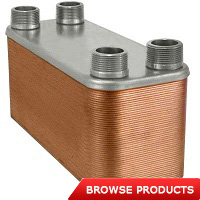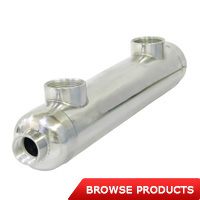Brazetek liquid to liquid and water to water heat exchangers
Depending on the flow rate and volume as well as chemical properties of liquids that have to undergo the heat transfer process, a shell and tube or a brazed plate heat exchanger is chosen accordingly.
Each of the above has advatanges and disadvantages which may determine the appropriatness of the heat exchanger for a specific application.
Compatibility with various liquids and chemicals
Checking whether a specific type of liquid is compatible with a heat exchanger is essentially the same as checking the compatibility of the materials of which the heat exchanger is made of with these same liquids.
The most common use of Brazetek products is for water to water heat transfer and therefore makes them suitable for applications such as domestic hot water heating, radiant floor heating, solar heating, snow melting and similar applications. In addition:
Brazed plate models can be used (and are UL certified) for use with refrigerant in HVACR applications and for wort chilling (both for DIY's and professionals).
Shell & tube models can be used for swimming pool heating (chlorinated water) and marine applications (STX only).
Brazed Plate Liquid to Liquid Heat Exchangers
 |
Available sizes: · 3" x 8": 10-50 plates, 3/4" Male NPT and 3/4" Female NPT connections (on select models). · 4-1/4" x 12": 10-70 plates, 1" Male NPT connections. · 5" x 12": 50-100 plates, 1-1/4" Male NPT connections, mounting studs on select models. · 10" x 20": 10-100 plates, 1-1/2" and 2" Male NPT connections.
|
Shell and Tube Liquid to Liquid Heat Exchangers
 |
Available sizes: · Both ST (316L St. Steel) and STX (Titanium) Series are available in models ranging from 55 KBTU to 1,200 KBTU with connection sizes from 3/4" to 2-1/2" Female NPT.
|





